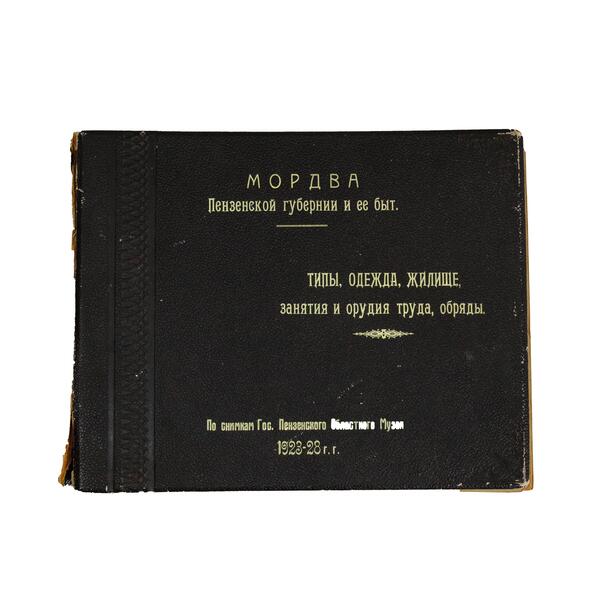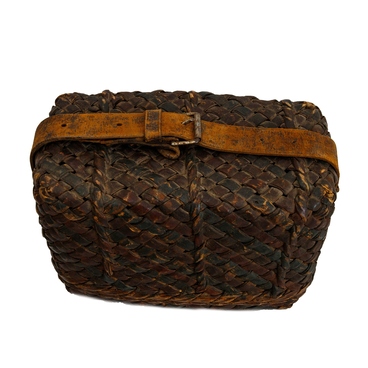The exhibition houses a photo album “The Mordvins of Penza Governorate. Based on photos of the State Penza Regional Museum from 1923 to 1928.”
The “Types” section contains 13 portrait and group photos of villages Vechenino, Vadovoye Selishche, Promzino of Bednodemyanovsky Uyezd, Volgapino, Lesnoe Ardashevo, Staraya Samayevka of Krasnoslobodsky Uyezd, and Pazelki of Gorodishchensky Uyezd citizens. The “Clothes” section contains the photos of women’s national costumes of the Moksha of Krasnoslobodsky and Bednodemyanovsky Uyezds and the Erzya of Saransky and Gorodischensky Uyezds. The photos of “The Dwelling” section represent village streets, houses, outbuildings, and the interior of “white” izbas (with stoves and with chimneys) and “black” izbas (with stoves but without chimneys). “Occupations and tools of labor” section has photos, showing the crafts connected with forest — tar distillation and carbonization. They also tell us about peasants’ daily routine: millet grinding, manual grain milling, hemp processing. The section “Spring Celebrations” contains photos of Whitsun traditions: seeing off spring, remembrance of ancestors, and youth festivals. Finally, the last section displays photos of the halls of the ethnographic department of the Penza Regional Museum, created by Nonna Sprygina in 1926 as a result of her expeditions.
In the foreword to the album, the author told the story of the development of the Mordovian collection of the Penza Regional Museum and the opening of the exhibition devoted to the life and costume of the Moksha and Erzya. Inspired by the success of her work, the scientist planned “to begin the study of the Russian and Tatar Governorates, to study more the Mordovin culture by combining the study of modern material culture with the study of the past, to identify the national identity, the evolution of its culture.”
Nonna Sprygina was born on March 3, 1880 in Odessa. She graduated from the Penza Gymnasium, was an active member of the Penza Society of Natural Science Lovers, took part in the creating and then in the activities of the Penza Natural History Museum. Sprygina founded the archaeology and ethnography department in the museum after completing a course in archaeology and ethnography.
She made a great contribution to the study of the region as an ethnographer. Sprygina’s first serious research in this field dates to the period of the establishment of the All-Union Agricultural and Artisanal-Industrial Exhibition in 1923. She led an expedition focused on collecting material on the everyday life of the Moksha and Erzya peoples. From 1923 to 1925, scientists explored the Gorodischensky, Krasnoslobodsky and Bednodemyanovsky Uyezds of Penza Province, where they gathered rich collections of tools, household utensils, clothing. Sprygina was awarded a diploma of the first degree for this work by the Glavvystavkom (Main Exhibition Committee). She wrote a book “Clothing of the Mordvin-Moksha of Krasnoslobodsky and Bednodemyanovsky Uyezds of the Penza Province” based on the outcomes of the expedition. The book was published in 1928. In the same year, the presented photo album was published.
In 1944, Nonna Sprygina moved to Moscow, where she died on July 23, 1953. Her daughter Lyudmila presented the family archive to the State Archive of the Penza region.
The “Types” section contains 13 portrait and group photos of villages Vechenino, Vadovoye Selishche, Promzino of Bednodemyanovsky Uyezd, Volgapino, Lesnoe Ardashevo, Staraya Samayevka of Krasnoslobodsky Uyezd, and Pazelki of Gorodishchensky Uyezd citizens. The “Clothes” section contains the photos of women’s national costumes of the Moksha of Krasnoslobodsky and Bednodemyanovsky Uyezds and the Erzya of Saransky and Gorodischensky Uyezds. The photos of “The Dwelling” section represent village streets, houses, outbuildings, and the interior of “white” izbas (with stoves and with chimneys) and “black” izbas (with stoves but without chimneys). “Occupations and tools of labor” section has photos, showing the crafts connected with forest — tar distillation and carbonization. They also tell us about peasants’ daily routine: millet grinding, manual grain milling, hemp processing. The section “Spring Celebrations” contains photos of Whitsun traditions: seeing off spring, remembrance of ancestors, and youth festivals. Finally, the last section displays photos of the halls of the ethnographic department of the Penza Regional Museum, created by Nonna Sprygina in 1926 as a result of her expeditions.
In the foreword to the album, the author told the story of the development of the Mordovian collection of the Penza Regional Museum and the opening of the exhibition devoted to the life and costume of the Moksha and Erzya. Inspired by the success of her work, the scientist planned “to begin the study of the Russian and Tatar Governorates, to study more the Mordovin culture by combining the study of modern material culture with the study of the past, to identify the national identity, the evolution of its culture.”
Nonna Sprygina was born on March 3, 1880 in Odessa. She graduated from the Penza Gymnasium, was an active member of the Penza Society of Natural Science Lovers, took part in the creating and then in the activities of the Penza Natural History Museum. Sprygina founded the archaeology and ethnography department in the museum after completing a course in archaeology and ethnography.
She made a great contribution to the study of the region as an ethnographer. Sprygina’s first serious research in this field dates to the period of the establishment of the All-Union Agricultural and Artisanal-Industrial Exhibition in 1923. She led an expedition focused on collecting material on the everyday life of the Moksha and Erzya peoples. From 1923 to 1925, scientists explored the Gorodischensky, Krasnoslobodsky and Bednodemyanovsky Uyezds of Penza Province, where they gathered rich collections of tools, household utensils, clothing. Sprygina was awarded a diploma of the first degree for this work by the Glavvystavkom (Main Exhibition Committee). She wrote a book “Clothing of the Mordvin-Moksha of Krasnoslobodsky and Bednodemyanovsky Uyezds of the Penza Province” based on the outcomes of the expedition. The book was published in 1928. In the same year, the presented photo album was published.
In 1944, Nonna Sprygina moved to Moscow, where she died on July 23, 1953. Her daughter Lyudmila presented the family archive to the State Archive of the Penza region.



